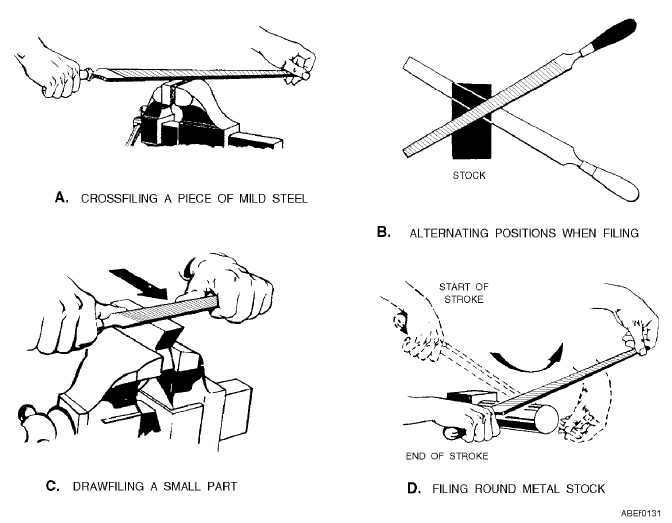SQUARE files are tapered on all four sides and are
used to enlarge rectangular-shaped holes and slots.
ROUND files serve the same purpose for round
openings. Small round files are often called "rattail"
files.
The HALF ROUND file is a general-purpose tool.
The rounded side is used for curved surfaces, and the
flat face on flat surfaces. When you file an inside curve,
use a round or half-round file whose curve most nearly
matches the curve of the work.
Kits of small files, often called "swiss pattern" or
"jewelers'" files, are used to fit parts of delicate
mechanisms and for filing work on instruments. Handle
these small files carefully because they break easily.
Filing Operations
Using a file is an operation that is nearly
indispensable when working with metal. You may be
crossfiling, drawfiling, using a file card, or even
polishing metal. Let's examine these operations.
When you have finished using a file, it may be
necessary to use an abrasive cloth or paper to finish the
product. Whether this is necessary depends on how fine
a finish you want on the work.
CROSSFILING.—Figure 1-21, view A, shows a
piece of mild steel being crossfiled. This means that the
file is being moved across the surface of the work in
approximately a crosswise direction. For best results,
keep your feet spread apart to steady yourself as you
file with slow, full-length, steady strokes. The file cuts
as you push it—ease up on the return stroke to keep
from dulling the teeth. Keep your file clean.
View B shows the alternate positions of the file
when an exceptionally flat surface is required. Using
either position first, file across the entire length of the
stock. Then, using the other position, file across the
entire length of the stock again. Because the teeth of the
file pass over the surface of the stock from two
directions, the high spots and low spots will readily be
visible after filing in both positions. Continue filing
first in one position or direction and then the other until
1-15
Figure 1-21.—Filing operations.


